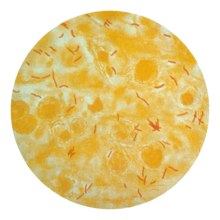
A person can become infected with tuberculosis bacteria when he or she inhales minute particles of infected sputum from the air. The bacteria get into the air when someone who has a tuberculosis lung infection coughs, sneezes, shouts, or spits. People who are nearby can then possibly breathe the bacteria into their lungs. Tuberculosis is spread primarily from person to person by breathing infected air during close contact.
There is a form of atypical tuberculosis, however, that is transmitted by drinking unpasteurized milk. Related bacteria, called Mycobacterium bovis, cause this form of TB. Previously, this type of bacteria was a major cause of TB in children, but it rarely causes TB now since most milk is pasteurized (undergoes a heating process that kills the bacteria).
What happened to the body when a person gets TB?
When the inhaled tuberculosis bacteria enter the lungs, they can multiply and cause pneumonia. The local lymph node associated with the lungs may also become involved with the infection and usually become enlarged.
In addition, TB can spread to other parts of the body. The body's immune (defense) system, however, can fight off the infection and stop the bacteria from spreading. The immune system does so ultimately by forming scar tissue around the TB bacteria and isolating it from the rest of the body. Tuberculosis that occurs after initial exposure to the bacteria is often referred to as primary TB. If the body is able to form scar tissue (fibrosis) around the TB bacteria, then the infection is contained in an inactive state. Such an individual typically has no symptoms and cannot spread TB to other people. The scar tissue and lymph nodes may eventually harden, like stone, due to the process of calcification of the scars(deposition of calcium from the bloodstream in the scar tissue). These scars often appear on X-rays and imaging studies like round marbles and are referred to as a granuloma. If these scars do not show any evidence of calcium on X-ray, they can be difficult to distinguish from cancer

Chest X-ray showing tuberculosis
Sometimes, however, the body's immune system becomes weakened, and the TB bacteria break through the scar tissue and can cause active disease, referred to as reactivation tuberculosis or secondary TB. For example, the immune system can be weakened by old age, the development of another infection or a cancer, or certain medications such as cortisone, anticancer drugs, or certain medications used to treat arthritis or inflammatory bowel disease. The breakthrough of bacteria can result in a recurrence of the pneumonia and a spread of TB to other locations in the body. The kidneys, bone, and lining of the brain and spinal cord (meninges) are the most common sites affected by the spread of TB beyond the lungs.
- Weakness
- Weight loss
- Fever
- Night sweats
- Coughing
- Chest pain
- Coughing up sputum or blood
- Shortness of breath

If the infection with tuberculosis has occurred recently, however, the skin test can be falsely negative. The reason for a false-negative test with a recent infection is that it usually takes two to 10 weeks after the time of infection with tuberculosis before the skin test becomes positive. The skin test can also be falsely negative if a person's immune system is weakened or deficient due to another illness such as AIDS or cancer, or while taking medications that can suppress the immune response, such as cortisone or anticancer drugs.

Mantoux skin test
*TB skin test cannot determine whether the disease is active or not.
**TB skin tests should not be done when a person has had a previous positive reaction as they are more likely to have a severe local reaction.
Treatment and Prevention
Vaccination : Bacille Calmette Guerin (BCG)
BCG
Active TB is treated with combination of medication along with isoniazid. Rifampin (Rifadin), ethanbutol (Myambutol), and pyrazinamide are the drugs commonly used to treat active TB in conjunction with isoniazid (INH). Four drugs are often taken for the first two months of therapy to help kill any potentially resistant strains of bacteria. Then the number is usually reduced to two drugs for the remainder of the treatment based on drug sensitivity testing that is usually available by this time in the course. Streptomycin, a drug that is given by injection, may be used as well, particularly when the disease is extensive and/or the patients do not take their oral medications reliably (termed "poor compliance"). Treatment usually lasts for many months and sometimes for years.
Successful treatment of TB is dependent largely on the compliance of the patient. Indeed, the failure of a patient to take the medications as prescribed is the most important cause of failure to cure the TB infection. In some locations, the health department demands direct monitoring of patient compliance with therapy.




















0 comments:
Post a Comment